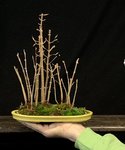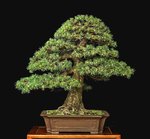In that case, is it not more ethical to only start with trees under say, 50 years old or less, to specifically train them as old looking trees?
For example, someone takes a 500 year old juniper from it’s spot of isolated existence. The place where it was born has too much sustenance for it to die, and too little for it to thrive, yet it has existed through all of humanity’s major and most destructive development. Now, that person has reduced it’s chances of survival for another 500 years right down to very close to zero. As well as they may act as it’s custodian, they would be relying on 10, 20 or more further generations to sustain it’s natural lifetime. There aren’t many Bonsai, relatively speaking, of anywhere near that age (as in training age).
and
You could say that about any tree, probably, but a tree that has gotten used to the rigours of a hard life would have more chance of reaching 1000 years than a whippersnapper with delusions of grandeur has of reaching 500. Would it not?





